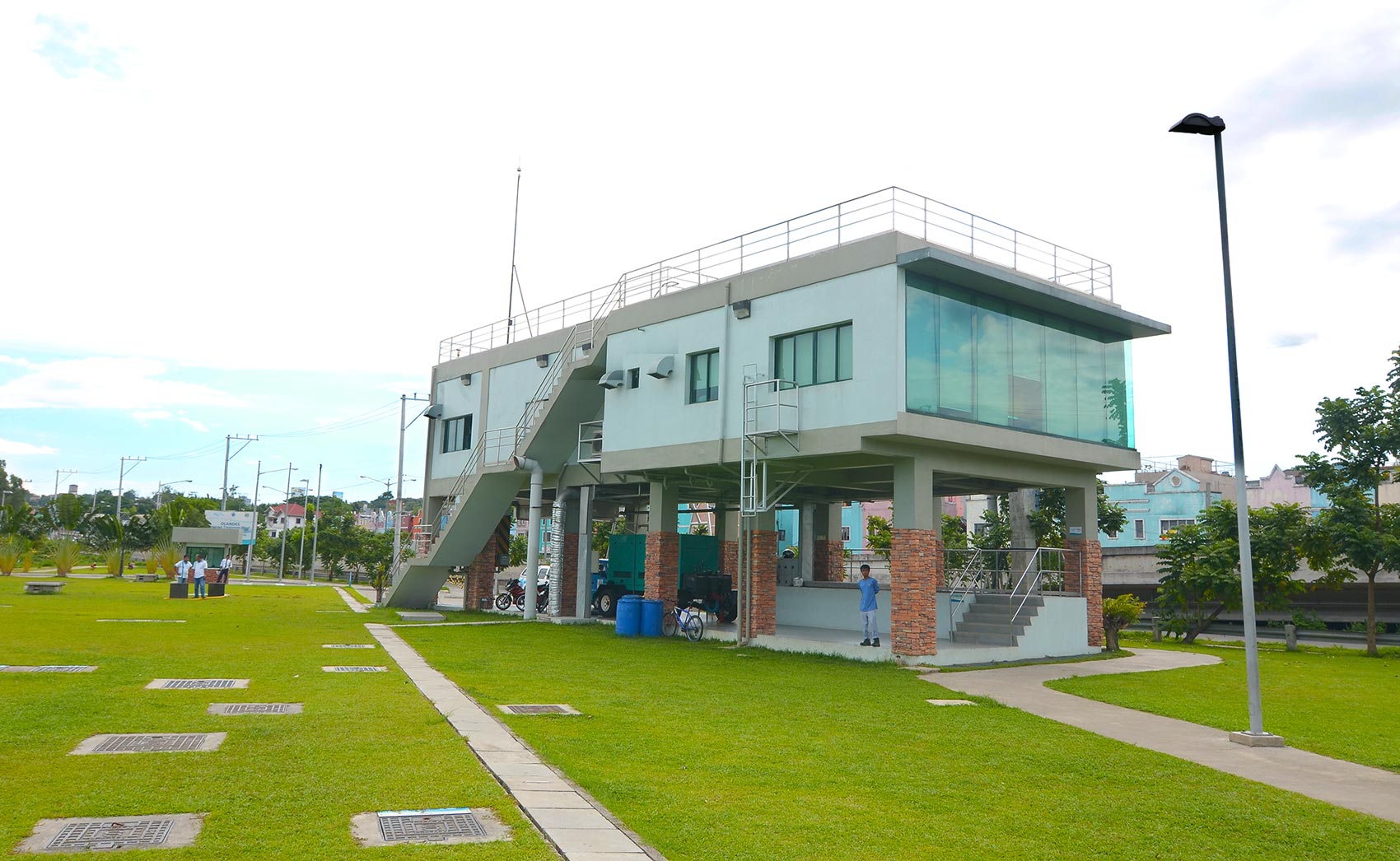
The Olandes Sewage Treatment Plant, a recipient of the 2010 Project Innovation Honors Award from the International Water Association, has an underground sewage treatment facility while the building where the equipment are located is on stilts to withstand flooding in the area.
Manila Water takes the threat of climate change with great priority. While climate change poses risks to business operations, it also creates opportunities for the company. Manila Water is stepping up to the challenge of mitigating the impacts of climate change and seizing the opportunities to create shared value for its stakeholders. In 2021, Manila Water publicly signified its support to TCFD and its recommendations.
Governance
Disclosure of the organization's governance around climate-related risks and opportunities
Board Oversight on Climate Risk Governance
The Board has overall responsibility for Manila Water's response to climate change and general oversight of the Company's approach to identifying, assessing, and managing both the risks and opportunities associated with climate change. The Company's top threats are reported to the Board Risk Oversight Committee (BROC) every quarter. The BROC provides oversight to management functions relating to strategic, financial, operational, compliance, legal, environmental, social, and other risks of the Company including periodic disclosure of significant risk exposures and related risk management activities.
In 2021, an amendment was made in the BROC’s charter that specifically includes the oversight of climate change risk as a function of the board further reinforcing the company’s commitment to address the risks and opportunities faced by climate change. Specifically, the BROC shall:
- Ensure that climate-related risks and opportunities, strategies and mitigations are discussed at least annually or as needed during committee meetings.
- Provide recommendations to ensure timely and appropriate strategies to mitigate climate-related risks and seize opportunities.
- Review and evaluate the company’s Climate Change Policy, climate risk appetite and ensure that resources are allocated to address climate-related issues.
- Assign authority, responsibility, and accountability at appropriate levels within the organization.
- Monitor and oversee progress against goals and targets for addressing climate-related issues.
- Report to the Board of Directors on the current and emerging top climate-related risks and strategies as necessary or at least annually.
Management Oversight on Climate Governance
As part of Manila Water’s commitment to identifying, assessing, and managing the risks and opportunities associated with climate change, the Manila Water Climate Change Policy was created. This included forming a Climate Change Council which was established in 2014.
Strategy
Disclosure of the actual and potential impacts of climate-related risks and opportunities on the organization’s businesses, strategy, and financial planning
Manila Water’s operations in water and wastewater services are susceptible to changes in patterns of the hydrologic or water cycle. Warming temperatures, changes in rainfall and runoff, extreme weather conditions, and sea level rise have affected and will continue to affect water supply and quality, as well as the ability of the water and wastewater assets to withstand natural disasters and could lead to intermittent or long-term failure to serve customers.
Manila Water was the first company in the Philippines to adopt a Climate Change policy to ensure that the company considers climate change impacts in its decision-making in 2007. Originally adopted in 2007, Originally adopted in 2007, Manila Water Climate Change Policy has evolved over the years in line with the company and the ongoing scientific research being produced, along with the governmental and regulatory policies being enacted.
Climate-related Risks and Opportunities of Manila Water
Physical Risks

Opportunities

Manila Water has already started addressing some of its opportunities which include:
- Use of energy and resource-efficient technologies and practices that will reduce costs and provide other intangible benefits
- Use of renewable energy to reduce GHG emission
- Expansion of wastewater and sanitation services
- Protection and rehabilitation of watersheds
The company continues to work at enhancing its climate-driven opportunities to ensure continued value protection and creation.
Impacts of Climate-related risks
Climate Change Council conducted an assessment on the impact of climate change on Manila Water’s operations. The climate change projections of PAGASA were considered in the assessment of the impacts of climate change on the company.
The Company has commissioned a consultant to determine the financial impacts of physical risks and transitional risks of different climate scenarios.
| Climate-Related Risk |
TCFD Category |
Impact Factors |
|
Increased severity of extreme weather events such as typhoons and floods
|
Physical
|
- Raw water quality issues due to high turbidity for both dam and deep wells
- Dam spilling causing flood to communities
- Business/operations interruption due to facility and equipment damage
- Increase in capital expenditure due to emergency works and retro fitting of assets
- Increase in operating expenses due to the use of gensets and higher treatment costs
- Employees' inability to report for work due to illness and/or lack of access to
- Facilities and/ or employees requiring assistance
- Supply Chain disruption
|
|
Drought
|
Physical
|
- Water allocation conflicts among users of water resources (e.g. water supply, power generation, irrigation, etc.)
- Poor raw water quality due to increase in sediments, microbes, and algae
- Water shortage in the service area
- Lower billed volume leading to lower revenues
- Increase in OPEX due to higher generation costs, water treatment costs, and use of genset
|
|
Rising mean temperatures
|
Physical
|
- Higher billed volume due to higher water demand from customers
|
|
Rising sea levels
|
Physical
|
- CAPEX investment for the relocation of facilities in low-lying areas
- Population displacement:
- For low lying areas-disappearance in communities.
- For areas of high elevations-increase in water demand
|
Risk Management
Disclosure of how the organization identifies, assesses, and manages climate-related risks
Climate risk is included in the ERM process as a risk driver. The ERM process is detailed here.
To support the Climate Change commitments of the company in the Climate Change Policy, the Climate Change Council regularly monitors, validates, and reviews short-term, medium-term, and long-term investment and operating plans and targets aligned to the Company's climate change commitments and goals. It is headed by the Chief Sustainability Officer or the Sustainability Head and participated by cross functional representatives from the Enterprise Risk Management & Sustainability functions, Business Continuity, Water Source department, Energy department, Compliance and Watershed Management department, and Strategic Asset Management Group. The council expanded to include members from Boracay Water, Cebu Water, Clark Water, and Laguna Water in 2017. Representatives from Estate Water and MWPV Head office representing new business units are the Council's new members in 2020.
Metrics and Targets
Disclosure of the metrics and targets used to assess and manage relevant climate-related risks and opportunities where such information is material.
Manila Water’s strategy to mitigate the impacts of climate change focuses on climate change adaptation while reducing and avoiding greenhouse gas emissions. Through the years, the company has undertaken measures to support its strategies and commitments indicated in its Climate Change Policy.
| Commitment |
Performance |
|
Institutionalize resiliency and adaptation assessment in the planning, construction, operation, and maintenance of all assets
|
- Ongoing Climate Scenario Assessment for the Manila Water Enterprise
- Completed Resiliency and Business Interruption Study for the East Zone and Laguna Water
- Developed resiliency projects based on the RBI Studies and include in the 2018 Business Plan for approval of MWSS
|
|
Retrofit existing assets and build new assets to be climate-resilient
|
- Retrofitted and ongoing retrofitting of assets that are vulnerable to typhoon and flooding
- Constructed eight (8) emergency reservoirs in the East Zone
|
|
Strengthen the disaster risk reduction and management capacity of the organization
|
- Business Continuity Policy is in place.
- Developed Emergency Preparedness and Response Procedures and conducts regular drills
- Created Emergency Preparedness and Response Groups
- Invested in business continuity equipment necessary for contingency and EPR, such as generator sets, mobile treatment plants, water tankers, and static tanks.
|
|
Take a proactive role in developing, protecting, rehabilitation, and enhancing water sources, including watersheds, surface, and groundwater resources
|
- Manila Water has a water supply masterplan to ensure sufficient water supply for provision to customers. The company undertakes continuous development of water sources to have enough water buffer.
- Manila Water protects and reforests key watersheds.
|
|
Continue to undertake climate change mitigation programs
|
- Manila Water reduced 9,102 tons CO2e by using on-site solar panels and purchasing renewable energy.
- Manila Water’s wastewater treatment avoided 51,814 tons CO2e carbon emission.
- Manila Water protects and reforests key watersheds which helps in carbon sequestration. As of 2021, the company has planted and nurtured 1,255,612 trees since 2006.
|
|
Build and enhance the knowledge, values, and capacities of employees, government, customers, supply chain, and other relevant stakeholders on climate change adaptation and mitigation
|
- Manila Water continuously engages its stakeholders in environmental and sustainability topics to promote environmental protection and sustainability.
|
|
Adopt an inclusive and partnership approach with relevant stakeholders in our climate change undertaking
|
- Manila Water is an active member of the Philippine Disaster Resilience Foundation and has partnerships with National Disaster Risk Reduction Management, Metropolitan Manila Development Authority, Bureau of Fire of the Philippines, and Philippine National Red Cross for its various DRRM initiatives.
- The company has partnership with several partners in its watershed management program.
- The Toka Toka advocacy partners with the national government, LGUs and private organizations to educate and engage stakeholders on solid waste and wastewater management.
|
|
Continuously monitor, review, assess, improve, and report our climate change response initiatives
|
- Manila Water published its 2015-2020 Climate Change Report.
- Manila Water voluntarily disclosed in CDP for its Climate Change and Water Security Disclosures. The company had a rating of C for its Climate Change Disclosures and B for its Water Security Disclosures.
|

Manila Water prevents methane emission that has 21x global warming potential from septic tanks by treating wastewater in aerobic sewage treatment plants.
Greenhouse Gas Emissions, tons CO2e
|
2019 |
2020 |
2021 |
|
Scope 1
|
4,913
|
5,418
|
6,428
|
|
Scope 2
|
175,745
|
197,229
|
187,167
|
|
Scope 3
|
1,564
|
1,046
|
1,532
|
|
Total
|
182,222
|
203,694
|
195,127
|
Manila Water started Greenhouse Gas Accounting in 2010 to monitor its GHG emissions. Manila Water's GHG emission decreased in 2021 brought about by the decrease in energy consumption and purchase of renewable energy. Details of the initiatives are discussed here.
Manila Water has the following 2025 targets aligned to each business unit forward plans in order to provide water and wastewater services while reducing and avoiding greenhouse gas emissions:
- At least 15% water buffer
- 60% carbon reduction and avoidance through renewable energy and other initiatives
- Building infrastructures sufficient to satisfy service improvements
The company is set to develop a roadmap for its net zero target aligned to a 1.5 C temperature increase which will include reduction of Scopes 1, 2, and 3 in near-term and long-term horizons and carbon neutralization through wastewater treatment and forest carbon capture.






